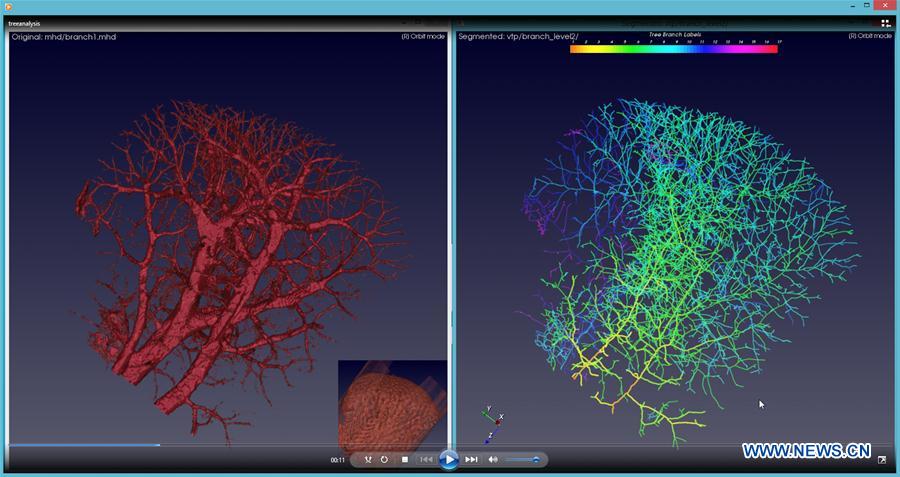
Image provided by CSIRO shows comparison of the enhanced blood vessel prior to skeletonisation (LHS) (left) and after the end-point skeletonisation process (RHS) (right). A team of Australian and Chinese scientists have developed sophisticated new software which could play a key role in the early detection of cancer. Australia's Commonwealth Scientific and Industrial Research Organisation (CSIRO) released a statement on Wednesday saying the partnership has developed an algorithm which detected the formation of new blood vessels, known to precede the growth of cancers, in mice. (Xinhua/CSIRO)
CANBERRA, May 31 (Xinhua) -- A team of Australian and Chinese scientists have developed sophisticated new software which could play a key role in the early detection of cancer.
Australia's Commonwealth Scientific and Industrial Research Organisation (CSIRO) released a statement on Wednesday saying the partnership has developed an algorithm which detected the formation of new blood vessels, known to precede the growth of cancers, in mice.
CSIRO's Data61 researchers joined forces with researchers at the Shanghai Institute of Applied Physics, Chinese Academy of Sciences to analyse images of the brains and livers of mice at different stages of cancer growth.
Together, the team looked at high-resolution 3D micro-CT images produced by the Shanghai Synchrotron Radiation Facility (SSRF) of 26 mice.
These images helped the researchers develop the algorithm which discovered the formation of new blood vessels. The scientists are hopeful that earlier detection of blood vessel growth could lead to a faster diagnosis of malignant tumor growth, a key factor in successful treatment and patient survival.
"In the past people were just able to get a rough idea but, with new technology, we are able to see the microvasculature which are very fine structures," Dr Wang Dadong, lead researcher on the project, told Xinhua on Wednesday.
While the research marks a significant step forward in cancer detection, the Shanghai Synchrotron Beamline used to produce the images generates radiation levels not safe for humans.
Wang told Xinhua he was unsure how long it will take before this new detection method is safe for human application.
"The technology is moving forward very fast, but we are still looking for a safe life source for human trial. Our software is being packaged, and it's ready for trial, we're just looking for partners to do the trials," Wang said.
In order to progress clinical trials on humans, the researchers are looking for 3D imaging technologies and partnering with a hardware manufacturer that can produce high-resolution images with levels of radiation safe for humans.
"But we are very hopeful, and currently looking for collaborators and partners to take the technology to the next stage," said Wang.















